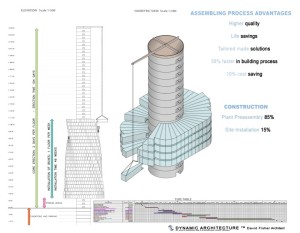Peter Lobner
David Fisher is the leading proponent of dynamic architecture and the inventor of the shape-changing dynamic skyscraper. The shape-changing feature is a clear differentiator between the dynamic skyscraper and earlier symmetrical rotating high-rise buildings like Suite Vollard, which was the first rotating high-rise building. This unique residential building opened in 2001 in Brazil.
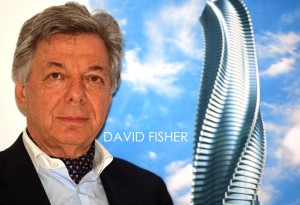 Source: costruzionipallotta.it
Source: costruzionipallotta.it
GE.DI Group
The GE.DI Group is an Italian construction firm that has become a leading proponent of new construction systems, including David Fisher’s dynamic architecture.
“GE.DI. Group (GEstione DInamica stand for Dynamic Management) in 2008, decided to embark on a new era of architecture: the Dynamic Architecture, a project of the architect David Fisher for rotating towers, continually evolving: dynamic, ecological, made with industrial systems.”
“The revolution of Fisher put an end to the era of the static and immutable architecture and it inaugurates a new one, at the sign of the dynamism and the lifestyle. These buildings will become the symbol of a new philosophy that will change the image of our cities and the concept of living.”
More information on GE.DI Group is available at the following link:
http://www.costruzionipallotta.it/dynamic_architecture_en.htm
Concept of a Dynamic Skyscraper
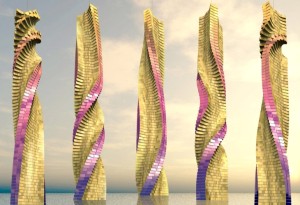 Shape-changing rotating skyscraper. Source: costruzionipallotta.it
Shape-changing rotating skyscraper. Source: costruzionipallotta.it
Three unique features of the dynamic skyscraper are:
1. Building exterior shape changes continuously: Each floor can rotate slowly thru 360 degrees independently of the other floors, with control over speed and direction of rotation. Coordination of the rotating floors to produce the artistic building shapes shown above may not be implemented in some applications. Nonetheless, the building’s exterior shape now has a fourth dimension: Time. The artistic possibilities of the dynamic skyscraper are shown (in time lapse) in the following 2011 video.
https://www.youtube.com/watch?v=QR2HukuFkQo
2. Prefabricated construction, except for the reinforced concrete core: After the reinforced concrete core has been completed and building services have been installed inside the core, factory manufactured prefabricated units will be transported to the construction site completely finished and will be hung from the central core. Connecting each rotating floor to electrical and water services in the stationary core will be an interesting engineering challenge. The extensive use of prefabricated construction (about 85% of total construction) greatly reduces site labor requirements, construction environmental impacts, and overall construction time. Read more on plans for prefabrication at the following link:
http://www.costruzionipallotta.it/prefabrication.htm
Assembly plan for a dynamic skyscraper. Source: Source: costruzionipallotta.it
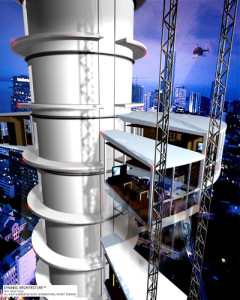 Prefabricated modules being lifted into place. Source: Source: costruzionipallotta.it
Prefabricated modules being lifted into place. Source: Source: costruzionipallotta.it
3. Generates its own electric power: Horizontal wind turbine generators installed in the approximately two-foot gap between the rotating floors will be the building’s primary source of power. Roof-mounted solar panels on each floor also will be employed. Surplus power will be delivered to the grid, delivering enough power to supply about five similarly sized buildings in the vicinity. Read more on the energy generating and energy saving features of the dynamic skyscraper at the following link:
http://www.costruzionipallotta.it/green_building.htm
 Wind turbine installation. Source: Source: costruzionipallotta.it
Wind turbine installation. Source: Source: costruzionipallotta.it
The first dynamic skyscraper may be built in Dubai
In a 14 February 2017 article entitled, “Dubai Will Have the World’s First Rotating Skyscraper by 2020,” Madison Margolin reported on the prospects for an 80-story mixed-use (office, hotel, residential) rotating skyscraper in Dubai. You can read the complete article on the Motherboard website at the following link:
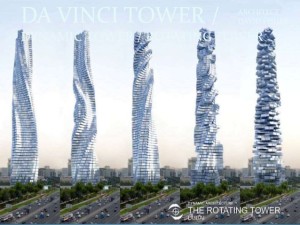 Source: http://www.slideshare.net/swapnika15/dynamic-da-vincirotating-tower
Source: http://www.slideshare.net/swapnika15/dynamic-da-vincirotating-tower
Each floor of the 420 meter (1,378 ft.) Da Vinci Tower will consist of 40 factory-built modules hung from the load-bearing 22-meter (72.2 ft.) diameter reinforced concrete core. Each module will be cantilevered up to 15 meters (49.2 ft.) from the core.
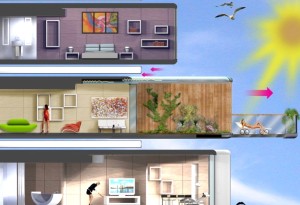 Cantilevered rotating floors. Source: costruzionipallotta.it
Cantilevered rotating floors. Source: costruzionipallotta.it
The lower retail / office floors of the Da Vinci Tower will not rotate. The upper hotel and residential floors will rotate and each will require about 4 kW of power to rotate. Each residential floor can be configured into several individual apartments or a single “villa.” You’ll find a concept for a “luxury penthouse villa” at the following link:
http://www.costruzionipallotta.it/lifestyle.htm
You’ll find more details on the Da Vinci Tower in a slideshow at the following link:
http://www.slideshare.net/swapnika15/dynamic-da-vincirotating-tower
If it is built, the Da Vinci Tower will be the world’s first dynamic skyscraper. It also will be David Fisher’s first skyscraper.
